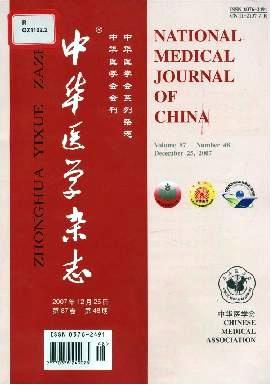[葡萄糖调节蛋白78在再生障碍性贫血发病机制中调节内质网应激]。
摘要
目的:探讨葡萄糖调节蛋白78 (GRP78)在再生障碍性贫血(AA)发病过程中调节内质网应激(ERS)的作用。方法:收集天津医科大学总医院2022年4月至2023年12月收治的AA患者的一般资料。根据治疗效果将新治疗的AA患者分为AA组,将缓解期AA患者分为R-AA组。将同期健康造血干细胞移植供者分为正常对照组(NC)。采集骨髓标本,分离CD8+T淋巴细胞,比较ers相关基因的表达情况。检测并比较GRP78蛋白表达水平,并与细胞因子进行相关性分析。对AA组骨髓CD8 + T淋巴细胞进行体外细胞实验,将AA组分为空白组(未处理)、tunicamycin (TM)组(10 μmol/L TM)、4-苯丁酸酯(4-PBA)组(0.6 μmol/L 4-PBA)和PERK抑制剂(PI)组(20 nmol/L PI)。根据处理浓度的不同,将TM组分为TM1组(TM2 μmol/L)、TM2组(TM 4 μmol/L)和TM3组(TM 8 μmol/L)。4-PBA组分为4-PBA1组(0.2 μmol/L)、4-PBA2组(0.4 μmol/L)和4-PBA3组(0.8 μmol/L)。PI组分为PI1组(10 nmol/L PI)、PI2组(20 nmol/L PI)、PI3组(30 nmol/L PI)。检测空白组、TM组、4-PBA组和PI组细胞中GRP78、CHOP蛋白表达水平和p-PERK/PERK磷酸化水平,并进行比较。比较TM组、4-PBA组和PI组间穿孔素和颗粒酶B的表达情况。结果:共纳入36例患者,其中AA组20例[男9例,女11例,年龄(44±19)岁],R-AA组16例[男10例,女6例,年龄(35±17)岁],NC组18例[男4例,女14例,年龄(44±8)岁]。AA组GRP78 mRNA表达量(分别为4.78±1.72、1.37±0.98和1.04±0.67)和PERK mRNA表达量(分别为7.19±3.44、3.42±1.46和2.47±1.15)均高于r -AA组和NC组(所有PM (Q1、Q3))[10.30%(9.25%、13.75%)vs 3.27%(2.41%、4.37%),P=0.003], GRP78蛋白表达与白细胞介素(IL)-2 (r=0.68, P=0.021)和γ-干扰素(IFN-γ) (r=0.64, P=0.036)呈正相关。体外细胞实验显示,TM组GRP78蛋白表达水平高于空白组,4-PBA组和PI组GRP78蛋白表达水平均低于空白组。PI组CHOP蛋白表达量低于空白组(均PP=0.046)。TM1、TM2、TM3组的穿孔素表达量均高于空白组,且TM3组的穿孔素表达量高于TM1、TM2组;TM1、TM2、TM3组颗粒酶B表达量均高于空白组;TM2和TM3组颗粒酶B表达水平高于TM1组(均为ppp)结论:GRP78调节ERS,激活CD8+T淋巴细胞,可能参与AA的免疫发病机制。Objective: To analyze the role of glucose-regulated protein 78 (GRP78) in regulating endoplasmic reticulum stress (ERS) in the pathogenesis of aplastic anemia (AA). Methods: The general information was collected on AA patients treated at Tianjin Medical University General Hospital from April 2022 to December 2023. According to the therapeutic effect, the newly treated AA patients were divided into the AA group, and the AA patients in remission were divided into the R-AA group. Healthy hematopoietic stem cell transplantation donors during the same period were divided into the normal control (NC) group. Bone marrow samples were collected and CD8+T lymphocytes were isolated to compare the expression of ERS-related genes. GRP78 protein expression level was detected and compared, and a correlation analysis with cytokines was conducted. In vitro cell experiments were conducted on bone marrow CD8⁺T lymphocytes in the AA group, which were divided into a blank group (no treatment), a tunicamycin (TM) group (10 μmol/L TM), a 4-phenylbutyrate (4-PBA) group (0.6 μmol/L 4-PBA), and a PERK inhibitor (PI) group (20 nmol/L PI). Based on different treatment concentrations, the TM group was divided into TM1 group (2 μmol/L of TM), TM2 group (4 μmol/L of TM), and TM3 group (8 μmol/L of TM). The 4-PBA group was divided into 4-PBA1 group(0.2 μmol/L of 4-PBA), 4-PBA2 group(0.4 μmol/L of 4-PBA), and 4-PBA3 group(0.8 μmol/L of 4-PBA). The PI group was divided into PI1 group(10 nmol/L of PI), PI2 group (20 nmol/L of PI), and PI3 group(30 nmol/L of PI). The expression levels of GRP78, CHOP proteins and the phosphorylation levels of p-PERK/PERK were detected and compared among the blank group, TM group, 4-PBA group, and PI group. The expression of perforin and granzyme B was compared among the subgroups of the TM group, 4-PBA group, and PI group. Results: A total of 36 patients were included, with 20 in the AA group [9 males and 11 females, aged (44±19) years], 16 in the R-AA group [10 males and 6 females, aged (35±17) years] and 18 in the NC group [4 males and 14 females, aged (44±8) years]. The mRNA expression levels of GRP78 (respectively 4.78±1.72, 1.37±0.98 and 1.04±0.67) and PERK (respectively 7.19±3.44, 3.42±1.46 and 2.47±1.15) in the AA group were higher than those in the R-AA group and the NC group (all P<0.05). The expression rate of GRP78 protein in the AA group [M (Q1, Q3)] was higher than that in the NC group [10.30% (9.25%, 13.75%) vs 3.27% (2.41%, 4.37%), P=0.003], and the expression of GRP78 protein was positively correlated with interleukin (IL)-2 (r=0.68, P=0.021) and γ-interferon (IFN-γ) (r=0.64, P=0.036). In vitro cell experiments showed that the expression levels of GRP78 protein in the TM group were higher than those in the blank group, the expression levels of GRP78 protein in the 4-PBA group and PI group were both lower than those in the blank group. The CHOP protein expression level in the PI group was lower than that in the blank group (all P<0.05). The p-PERK/PERK phosphorylation level in the PI group was lower than that in the blank group (P=0.046). The perforin expression levels in the TM1, TM2, and TM3 groups were all higher than those in the blank group, and the perforin expression level in the TM3 group was higher than that in the TM1 and TM2 groups; the expression levels of granzyme B in the TM1, TM2, and TM3 groups were all higher than those in the blank group; the expression levels of granzyme B in the TM2 and TM3 groups were higher than those in the TM1 group (all P<0.05). The expression levels of perforin in the 4-PBA1, 4-PBA2, and 4-PBA3 groups were all lower than those in the blank group; the perforin expression levels in the 4-PBA3 group were lower than those in the 4-PBA1 and 4-PBA2 groups (all P<0.05). The expression levels of perforin and granzyme B in the PI1, PI2, and PI3 groups were all lower than those in the blank group (P<0.05). Conclusion: GRP78 regulates ERS and activates CD8+T lymphocytes, which may be involved in the immune pathogenesis of AA.

 求助内容:
求助内容: 应助结果提醒方式:
应助结果提醒方式:


